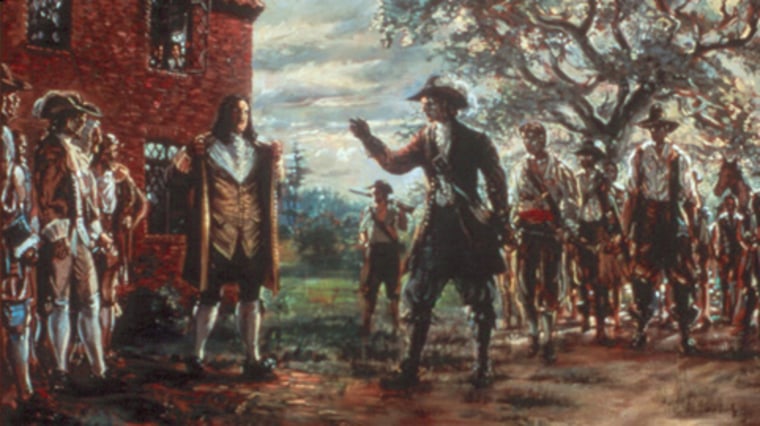From 1689 to 1763, England and France waged a war in Europe that extended to their respective colonies across the Atlantic. Known as the French and Indian Wars, these battles were largely fought by Indian allies of each country. Although the British prevailed, they quickly came to view their Indian allies as "savages." The English already had a well-developed sense of "savagery" from their long history with the Irish. They simply transferred their cultural attitudes and beliefs about the Irish to the Indians.
At the time, "captivity narratives" were popular among the colonists. The storyline usually involved an English woman, representing Puritan virtue, being captured by Indians. Faced with the choice of marriage to a “savage” or becoming an Indian sacrifice, the captive was ultimately saved and returned to “civilization,” providing a metaphor for Puritan beliefs about temptation, redemption and salvation. Among the more popular captivity novels of the time were: Cotton Mather's Humiliations Follow'd with Deliverances (1697); The Redeemed Captive (1704) by John Williams; and Jesuit Relations, a serial published by Jesuit missionaries from 1632-1673. Captivity narratives were a means of religious expression, reinforced Indian stereotypes, reflected cultural bias and justified the exploitation of Indians to satisfy European westward expansion.
The first recorded arrival of Africans in the Virginia colony was in 1619, when a Dutch warship brought 20 blacks captured from a Spanish slave ship, including three women, to Jamestown. Though not much is known about them, many of these early African arrivals had already been assimilated into European cultures. Some had Spanish or Portuguese names and spoke those languages. They came as agricultural laborers, but some of them may have been servants and easily fit into the system of indentured labor that was devised for poor Europeans.
During the 17th century, English workers came to Virginia in the thousands to work for at least six years as servants and laborers in return for passage to the New World. Black slaves and white indentured laborers worked along side each other on Virginia’s farms and tobacco plantations during the first 30 years of the colony’s history. African slaves and indentured Europeans were even known to marry and have children. More than a few slaves earned their freedom, acquired land or worked as skilled laborers for themselves. Indeed, the line between slavery and freedom was not always clearly defined in the early years. For the first 60 or 70 years after Jamestown was settled, the English used the terms "servant" and "slave" interchangeably. But by the 1660s, black captives were typically treated as slaves. They were assigned different work than whites and were no longer listed in ledger books or population counts with surnames, unlike white indentured servants. More importantly, a number of slave codes, or laws aimed at defining in detail the lives of enslaved persons, were enacted.
In 1620, a group of English settlers aboard the Mayflower landed in Massachusetts at a place they called Plymouth. Within 20 years, Africans were also living there, working as laborers and as slaves.
The Navigation Act, a series of English laws passed between the 1650s and 1660s to regulate the economy of the British Empire, triggered an exodus of Scots-Irish immigrants to North America. The long-running English battles with the Irish led to large numbers of captives who were shipped off to the Caribbean islands to work as slaves, especially during the reign of Oliver Cromwell. In the mid-17th century, there were more Irish slaves than African slaves in the Caribbean, according to historians.
In 1653, John Eliot published Catechism in the Indian Language, the first book printed in an Indian language. In 1661, he translated the Bible into the Algonquin language.
In 1700, Judge Samuel Sewall published The Selling of Joseph, among the first anti-slavery literature.
By the 1700s, the colonial population doubled roughly every 25 years. Between 1700 and 1770, 260,000 Africans, 50,000 white convicts and 210,000 immigrants from Western Europe arrived in the British colonies. Scots-Irish immigrants, who descended from Scottish immigrants in Northern Ireland, numbered roughly 80,000. Many Scots-Irish came as indentured servants. Approximately 70,000 immigrants from various German states migrated to the colonies during the same period.
From 1650 to 1700, an estimated half million Africans were brought to the Americas and the Caribbean. Between 1700 and 1750, another 2.3 million arrived; and between 1750 and 1800, more than 3.8 million Africans were imported as part of the trans-Atlantic slave trade.
In 1739, the deadliest slave revolt occurred in Stono, South Carolina, when armed slaves fled to Florida, a safe haven; the insurrection ended with 20 whites and more than 40 blacks killed.
In 1741, rumors of a slave revolt in New York City, where slaves made up one-fifth of the population, led to 30 slaves and four whites being hanged and burned at the stake, even though there was no proof of a conspiracy.
The Treaty of Paris was signed in 1763, ending the French and Indian War; France ceded Acadia — now Nova Scotia — and the rest of Canada to England.
